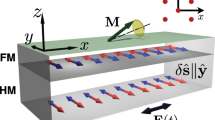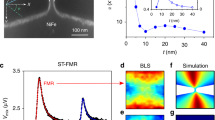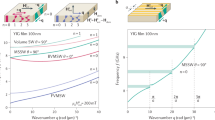Abstract
The phenomenon of spin resonance has had far-reaching influence since its discovery 70 years ago1. Electron spin resonance driven by high-frequency magnetic fields has enhanced our understanding of quantum mechanics, and finds application in fields as diverse as medicine and quantum information2. Spin resonance can also be induced by high-frequency electric fields in materials with a spin–orbit interaction; the oscillation of the electrons creates a momentum-dependent effective magnetic field acting on the electron spin3,4,5,6,7,8,9. Here we report electron spin resonance due to a spin–orbit interaction that does not require external driving fields. The effect, which we term ballistic spin resonance, is driven by the free motion of electrons that bounce at frequencies of tens of gigahertz in micrometre-scale channels of a two-dimensional electron gas. This is a frequency range that is experimentally challenging to access in spin resonance, and especially difficult on a chip. The resonance is manifest in electrical measurements of pure spin currents10—we see a strong suppression of spin relaxation length when the oscillating spin–orbit field is in resonance with spin precession in a static magnetic field. These findings illustrate how the spin–orbit interaction can be harnessed for spin manipulation in a spintronic circuit11, and point the way to gate-tunable coherent spin rotations in ballistic nanostructures without external alternating current fields.
This is a preview of subscription content, access via your institution
Access options
Subscribe to this journal
Receive 51 print issues and online access
$199.00 per year
only $3.90 per issue
Buy this article
- Purchase on Springer Link
- Instant access to full article PDF
Prices may be subject to local taxes which are calculated during checkout




Similar content being viewed by others
References
Rabi, I. I., Zacharias, J. R., Millman, S. & Kusch, P. A new method of measuring nuclear magnetic moment. Phys. Rev. 53, 318 (1938)
Zavoisky, Y. K. Spinmagnetic resonance in paramagnetics. J. Phys. USSR 9, 245–246 (1945)
Dyakonov, M. I. & Perel, V. I. Spin relaxation of conduction electrons in noncentrosymmetric semiconductors. Sov. Phys. Solid State 13, 3023–3026 (1972)
Bell, R. L. Electric dipole spin transitions in InSb. Phys. Rev. Lett. 9, 52–54 (1962)
Rashba, E. I. & Efros, A. L. Orbital mechanisms of electron-spin manipulation by an electric field. Phys. Rev. Lett. 91, 126405 (2003)
Duckheim, M. & Loss, D. Electric-dipole-induced spin resonance in disordered semiconductors. Nature Phys. 2, 195–199 (2006)
Kato, Y., Myers, R. C., Gossard, A. C. & Awschalom, D. D. Coherent spin manipulation without magnetic fields in strained semiconductors. Nature 427, 50–53 (2004)
Meier, L. et al. Measurement of Rashba and Dresselhaus spin-orbit magnetic fields. Nature Phys. 3, 650–654 (2007)
Nowack, K. C., Koppens, F. H. L., Nazarov, Y. V. & Vandersypen, L. M. K. Coherent control of a single electron spin with electric fields. Science 318, 1430–1433 (2007)
Frolov, S. M. et al. Electrical generation of pure spin currents in a two-dimensional electron gas. Phys. Rev. Lett. 102, 116802 (2009)
Wolf, S. A. et al. Spintronics: A spin-based electronics vision for the future. Science 294, 1488–1495 (2001)
Koop, E. J., van Wees, B. J. & van der Wal, C. H. Confinement-enhanced spin relaxation for electron ensembles in large quantum dots. Preprint at 〈http://arxiv.org/abs/0804.2968〉 (2008)
Potok, R. M., Folk, J. A., Marcus, C. M. & Umansky, V. Detecting spin-polarized currents in ballistic nanostructures. Phys. Rev. Lett. 89, 266602 (2002)
Koop, E. J. et al. Spin accumulation and spin relaxation in a large open quantum dot. Phys. Rev. Lett. 101, 056602 (2008)
Johnson, M. & Silsbee, R. H. Interfacial charge-spin coupling — Injection and detection of spin magnetization in metals. Phys. Rev. Lett. 55, 1790–1793 (1985)
Jedema, F. J., Filip, A. T. & van Wees, B. J. Electrical spin injection and accumulation at room temperature in an all-metal mesoscopic spin valve. Nature 410, 345–348 (2001)
Rashba, E. I. Properties of semiconductors with an extremum loop. Sov. Phys. Solid State 2, 1224–1238 (1960)
Dresselhaus, G. Spin-orbit coupling effects in zinc blende structures. Phys. Rev. 100, 580–586 (1955)
Acknowledgements
We thank M. Berciu, M. Duckheim, J. C. Egues, D. Loss and G. Usaj for conversations. Work at UBC was supported by NSERC, CFI and CIFAR. W.W. acknowledges financial support by the Deutsche Forschungsgemeinschaft (DFG) in the framework of the programme ‘Halbleiter-Spintronik’ (SPP 1285).
Author Contributions S.M.F., J.A.F., W.Y. and Y.R. performed experiments, S.L. performed Monte Carlo simulations, W.W. provided heterostructures, and S.M.F. and J.A.F. wrote the paper.
Author information
Authors and Affiliations
Corresponding author
Supplementary information
Supplementary Information
This file contains Supplementary Methods, Supplementary Data, a Supplementary References and Supplementary Figures S1-S4 with Legends (PDF 360 kb)
Rights and permissions
About this article
Cite this article
Frolov, S., Lüscher, S., Yu, W. et al. Ballistic spin resonance. Nature 458, 868–871 (2009). https://doi.org/10.1038/nature07873
Received:
Accepted:
Issue Date:
DOI: https://doi.org/10.1038/nature07873
This article is cited by
-
Ballistic transport spectroscopy of spin-orbit-coupled bands in monolayer graphene on WSe2
Nature Communications (2023)
-
Spin-momentum locked spin manipulation in a two-dimensional Rashba system
Scientific Reports (2019)
-
New perspectives for Rashba spin–orbit coupling
Nature Materials (2015)
-
A quantum dot spin qubit with thermal bias
Quantum Information Processing (2015)
-
Spin-Polarized Transport Through a Quantum Dot Coupled to Leads with Spin-Dependent Electron Temperature
Journal of Low Temperature Physics (2015)
Comments
By submitting a comment you agree to abide by our Terms and Community Guidelines. If you find something abusive or that does not comply with our terms or guidelines please flag it as inappropriate.



